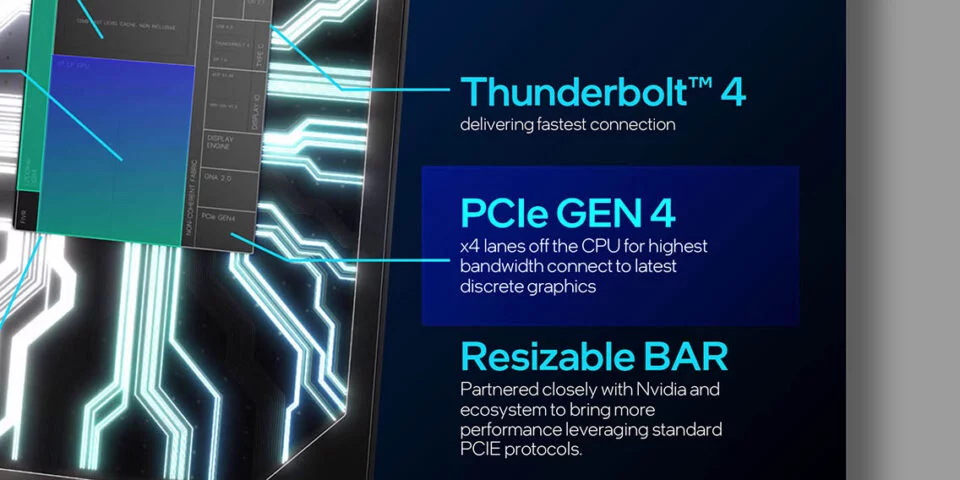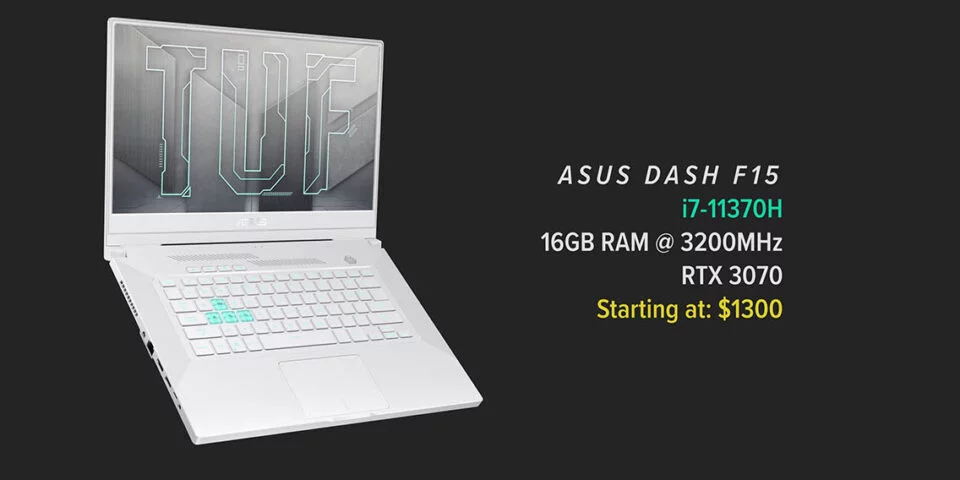Intel’s WEIRDEST CPU might be their BEST!

Share:
Table of contents
It looks like 2021 might be an the amazing year for the PC space, because an amazing battle is shaping up between AMD and Intel. More competition obviously means better choices for consumers and hopefully better prices from both sides. With all the big announcements from NVIDIA, Intel, AMD, and many other companies we wanted to focus on the less reported things, and that got us thinking about the small exciting CPU lineup from Intel that is codenamed Tiger Lake H35. We already know the Tiger Lake is reserved for the thin-and-light ultrabook side, you can check out our full explained article over here, but H35 dials up the architecture to 11 with better clock speeds and obviously better performance. Now this might look like a really weird move by Intel, but it actually opens up quite a lot of opportunities in the notebook space. Tiger Lake on steroids might make this the coolest and most exciting CPU from Intel.
Expanding The Segment
This chip really targets the ultraportable gaming form factor, and I know that’s not really a big market right now, but laptop manufacturers that we have spoken with think this is going to be like the next big deal. Given that Ryzen 4000 and 5000 are so popular on the mobile side, the Tiger Lake H35 might be a really smart way for Intel to steal back some market share in the high-performance ultrabook segment. We are going to talk about the specs, the performance, and does it actually add more confusion to an already complicated into lineup? Also we will highlight a few interesting devices featuring this new chip.
Let’s talk about this ultraportable gaming segment that Intel is trying to push their a Tiger Lake chips in. It’s not anything new, but Intel are just trying to push it to that next level. A few companies have already dipped their toes into the light-and-slim gaming space by blending ultrabook dimensions and discrete GPU’s into a sort of hybrid laptop. Some great examples of this are the Razer Blade Stealth, the amazing ASUS ROG Zephyrus G14, and the new Dell XPS 15, even though that one is productivity focused rather than gaming. While all those machines had pretty excellent performance across the board, the one thing that was lacking was GPU horsepower because they just ranged from GTX 1650 Ti all the way up to RTX 2060 Max-Q.
And so Tiger Lake H35 processors are meant to create a new niche with an efficient CPU architecture that specializes in lightly threaded workloads like games that also brings in really good GPU horsepower, with GPU’s ranging from the RTX 3060 Mobile all the way to RTX 3070 Mobile. The resulting laptops will sit right below the typical thin enthusiast 15-inch and 17-inch laptops like the Legion 5 or MSI GS65 Stealth, but provide even more portability and much longer battery life. The intent is to keep these laptops in the 14-inch and 15-inch form factors under 18mm in thickness, which is awesome for profitability. In terms of price expect to pay a slight premium because of the convenience of a small light powerful notebook, but at least all the other specs will be covered.
Roadmap
And at this point you are probably wondering why doesn’t Intel just use the existing Comet Lake H- and U-series processors, but simply put none of those processors can actually deliver what Tiger Lake H35 promises. And a lot of that has to do with the Willow Cove core architecture found in Tiger Lake. While Sunny Cove was a bit of a disaster this follow-up design offers much, much better performance and its frequency scales really well with voltage. Meanwhile, the 10nm process with SuperFin technology allows for a pretty efficient chip all things considered. Tiger Lake H35 is going to act like a bridge between the U- and H-series, so higher clock speeds and better overall gaming performance than the U-series or current Tiger Lake CPUs, but with less cores and more efficient than the H-series.
Intel had another little surprise for us too, and that was a glimpse into what their next generation of high-end H-series mobile CPU’s will look like. Those replacements for Comet Lake H will be coming in the second half of this year, and we will have up to 8 cores/16 threads, 20 PCIe Gen4 lanes, and we will also be based off the Tiger Lake architecture with the Willow Cove cores. These could be a very serious competitor for AMD’s Ryzen 5000H series, especially on the connectivity front with native Thunderbolt 4.
Specs
Now back to the H35, the real star of the show is Tiger Lake’s performance, especially in gaming since it offers a lot higher IPC and lightly performance than anything else in Intel’s laptop lineup, even the H-series cannot really compare. The only thing that matches the H35’s single thread performance is the super high-end i9-10980K, which is only available in really expensive gaming laptops. This is only a microscopic little snapshot of what this thing can do, plus they are handpicked benchmarks, but based on what Tiger Lake has shown us in the past these results are promising. There are a few other features I need to talk about since Tiger Lake CPU’s were originally designed to be used in ultrabooks there are only four PCIe Gen4 lanes from the CPU that can be used for graphics. From a bandwidth standpoint that equals to PCIe Gen3 x8 link speed, so don’t worry about bottlenecking the RTX 3060 Mobile or RTX 3070 Mobile since that should be plenty of bandwidth. One other cool features that Intel is also working with NVIDIA to bring Resizable Bar support to a number of their platforms, including Tiger Lake. That rollout is supposed to happen over time and progressively, but as it does we hopefully will see increased performance in some games.
The Lineup
So what does the lineup look like? Even though Intel went through a bit of a rebranding to try to simplify the naming schemes it still looks like a mess, but I’m going to do my best to try and explain it. All of these are 4 core/8 thread CPU’s with configurable TDP of 28W or 35W, but Intel expects the majority to ship in the 35W form. While the Core i7-11370H and the Core i5-11300H will probably be used in the majority of models, there is also an Core i7-11375H Special Edition. And that thing uses the highest bin Tiger Lake chips and clocks them to a maximum single core frequency of 5GHz. I should also mention that the Core i7’s get the XE graphics with 96 Execution Units, while the Core i5 gets 80 Execution Units. When compared to the highest-end Tiger Lake CPU available right now, you can see the 28W setting doesn’t change all that much, but at 35W the base clock gets extended by around 10%. But this only tells us a small part of the story because with the additional power and thermal headroom, the new H35 CPU’s should be able to sustain higher clock speeds for longer periods of time and achieve more consistent performance as well. Also remember that most Tiger Lake CPU’s that are out in market right now use the 15W setting versus the 28W setting, so that is also going to be a pretty big difference. The biggest advantage with Tiger Lake is going to be its relatively low TDP that will allow notebook manufacturers to maximize the thermal budgets that they have for the thin-and-light notebooks, while also using the more powerful discrete GPU’s.
Laptops
A good example of this is Acer’s new Predator Triton 300 SE, which is a sleek gray 14-inch gaming laptop that is just 17.99mm thick and weighs just 3.75 lbs. Inside there is the i7-11375H Special Edition, 16GB of memory, and an NVIDIA RTX 3060. Supposedly this is going to be available in February in the European Union for 1500 Euros and in North America starting in March for about $1,400 USD. Not really affordable, but if they can nail battery life, performance, build quality, and all the other features, this could be a really popular option especially for that niche of ultrabooks that are also gaming notebooks.
The other laptop I want to talk about is the TUF F15 15.6-inch gaming laptop that might have a similar name as the TUF A15 that we looked at last year, but it is super different. It is lighter and slimmer, a lot cleaner looking, and it packs some serious horsepower. This model gets the i7-11370H and 16GB of DDR4-3200 memory, along with an NVIDIA GeForce RTX 3070. It is all crammed into a grey and white chassis that is 19mm thick and weighs about 5 lbs. Not only that, but it comes with up to a 240Hz IPS display that covers 100% of the sRGB colour spectrum. Pricing on the TUF F15 starts at $1,300 USD and that puts it right in line with ASUS’s own Zephyrus G14 and a bit higher priced than their refreshed TUF A15.
Conclusion
I’m really excited to get Tiger Lake H35 into our hands to test out performance and see how it actually compares, especially because availability is supposed to be quite soon in February. We do have some reservations still because Tiger Lake H35 is not supposed to be this massive CPU powerhouse, but will it bottleneck the new high-end RTX 3070 Mobile and RTX 3060 Mobile. Intel tells us no, but we will have to test that for ourselves. I guess that is it for our little Tiger Lake H35 overview. It might not get the same amount of attention as AMD’s Zen 3 mobile lineup or even Intel’s Rocket Lake chips, but we feel it’s cool and hopefully it’s what everyone would want in the thin-and-light space.





























